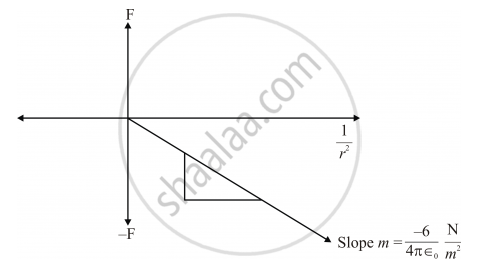Advertisements
Advertisements
प्रश्न
Plot a graph showing the variation of coulomb force (F) versus ,`(1/r^2)` where r is the distance between the two charges of each pair of charges: (1 μC, 2 μC) and (2 μC, − 3 μC). Interpret the graphs obtained.
उत्तर
I am answering it as Graph between F vs `1/r^2`for (1μC, 2μC)

For (2μC − 3μC)

Interpretation
Graphs show that `F ∝ 1/r^2`
-
Slope gives a constant value and depends only on nature of charges and medium.
-
Ist graph is for repulsive force in Ist quadrant and IInd graph is for attractive force in IVth quadrant i.e., F > 0 and F < 0 respectively.
APPEARS IN
संबंधित प्रश्न
Three-point charges q, – 4q and 2q are placed at the vertices of an equilateral triangle ABC of side 'l' as shown in the figure. Obtain the expression for the magnitude of the resultant electric force acting on the charge q

(b) Find out the amount of the work done to separate the charges at infinite distance.
At what separation should two equal charges, 1.0 C each, be placed, so that the force between them equals the weight of a 50 kg person?
Estimate the number of electrons in 100 g of water. How much is the total negative charge on these electrons?
A hydrogen atom contains one proton and one electron. It may be assumed that the electron revolves in a circle of radius 0.53 angstrom (1 angstrom = 10−10 m and is abbreviated as Å ) with the proton at the centre. The hydrogen atom is said to be in the ground state in this case. Find the magnitude of the electric force between the proton and the electron of a hydrogen atom in its ground state.
Ten positively-charged particles are kept fixed on the x-axis at points x = 10 cm, 20 cm, 30 cm, ...., 100 cm. the first particle has a charge 1.0 × 10−8 C, the second 8 × 10−8 C, the third 27 × 10−8 C and so on. The tenth particle has a charge 1000 × 10−8 C. Find the magnitude of the electric force acting on a 1 C charge placed at the origin.
What are the differences between the Coulomb force and the gravitational force?
For charges q1 and q2 separated by a distance R the magnitude of the electrostatic force is given by ______.
A spring of spring constant 5 × 103 N/m is stretched initially by 5 cm from the unstretched position. Then the work required to stretch it further by another 5 cm is:
Two point charges +2 C and +6 C repel each other with a force of 12 N. If a charge of -4 C is given to each of these charges, then the force now is ______.
What is meant by the statement: "Relative permittivity of water is 81"?
